Which of Today’s Six Featured Images is Your Favorite?
Why?
What’s Up?
Wednesday morning at JBWR was decent with fewer bugs and some nice cool air. The NW breeze freshened as the morning went on eliminating the mosquitoes but making photography more difficult. A strong onshore breeze at Nickerson in the afternoon made things fun, especially with midair skimmer battles. And several very late Black Skimmer nests hatched near the ropes so there are a few tiny chicks around.
Today is Thursday 25 August 2022. The forecast for the morning is a carbon copy of yesterday’s. I will be heading back to the East Pond very early. Wherever you are, and whatever you are doing, I hope that you too have a great day. This blog post took about 90 minutes to prepare and makes one hundred fifty-three days in a row with a new one.
Please remember to use the B&H and Amazon links that are found on most blog pages and to use the BIRDSASART discount code at checkout when purchasing your new gear from Bedfords to get 3% back on your credit card and enjoy free second-day air FedEx. Please, also, consider joining a BAA IPT. You will be amazed at how much you will learn!
Selling Your Used Photo Gear Through BIRDS AS ART
Selling your used (or like-new) photo gear through the BAA Blog is a great idea. We charge only a 5% commission on items priced at $1,000 or more. With items less than $1000, there is a $50 flat-fee. One of the more popular used gear for sale sites charged a minimum of 20%. Plus assorted fees! Yikes. They went out of business. And e-Bay fees are now up to 13%. If you are interested, please click here, read everything carefully, and do what it says. To avoid any misunderstandings, please read the whole thing very carefully. If you agree to the terms, please state so clearly via e-mail and include the template or templates, one for each item you wish to sell. Then we can work together to get your stuff priced and listed.
Stuff that is priced fairly — I offer pricing advice only to those who agree to the terms — usually sells in no time flat. Over the past years, we have sold many hundreds of items. Do know that prices for used gear only go in one direction. Down. You can always see the current listings by clicking here or on the Used Photo Gear tab on the orange-yellow menu bar near the top of each blog post page.
Sony a7RIV Full Frame Mirrorless Body
BAA Record-low Price!
Multiple IPT veteran Jim Miller is offering a Sony a7RIV Full Frame Mirrorless body in excellent plus to near mint condition for a BIRDS AS ART record-low $1897.00. The sale includes the original box, all manuals and documents, the front body cap, one battery and the charger with power cord, the USB-C/USB cable, the original product box, and insured ground shipping via major courier to lower-48 US addresses only. Your item will not ship until your check clears unless other arrangements are made.
Please contact Jim via e-mailor by phone at 850-445-5042 (Eastern time zone).
For the past several years you have seen the incredible detail in my a7r IV images made with a variety of SONY lenses and both teleconverters. Before the a1, I typically used my 7r IV for about 50% of my bird photography and my a9 II in pure flight situations. As the a7r IVA sells new right now for $3498.00 (and the only “improvement” over the original a7R IV is more resolution in the rear monitor), you can save a cool $1601.00 by grabbing Jim’s sweet a7r IV ASAP. Though this 61-MP body is especially attractive to landscape and macro photographers, it is great for birds as well; you can pretty much crop to your heart’s content. For photographing bird in flight, I do not recommend its use with the 200-600 G lens. artie
Sony G Master FE 100-400mm F/4.5-5.6 GM OSS Lens
BAA Record-low Price!
Jim Miller is offering a Sony G Master FE 100-400mm F/4.5-5.6 GM OSS lens in near-mint condition for a BIRDS AS ART record-low $1296.00. The sale includes the the original product box, the manuals, the front and rear lens caps, the nylon zippered case, the hood, the lens strap, and insured ground shipping via major courier to lower-48 US addresses only. Your item will not ship until your check clears unless other arrangements are made.
Please contact Jim via e-mailor by phone at 850-445-5042 (Eastern time zone).
This versatile, mega-close-focusing lens is easily hand holdable by most folks; it is much lighter than the 200-600 G lens. It is great for bird photography. I used mine often for flight photography, for head shots of silly-tame birds, and for large flowers, butterflies, frogs, and the like. It sells new for $2498.00 so you can save a handsome $1,2002 by grabbing Mark’s Jim’s lens today. artie
|
|
|
This image was also created on 21 August on an In-the-Field session at the north end of the East Pond at JBWR, Queens, NY. Again, while seated on damp mud and working off the titled rear monitor, I used the flattened, no-longer available except from BIRDS AS ART, Induro GIT 304L tripod/Levered-Clamp FlexShooter Pro-mounted Sony FE 600mm f/4 GM OSS lens, the Sony FE 2.0x Teleconverter (at 1200mm) and The One, the Sony Alpha 1 Mirrorless Digital Camera). Shutter Priority at zero. The exposure was determined via Zebra technology with Exposure Compensation on the thumb dial. AUTO ISO set ISO 4000. 1/500 sec. at f/8 (wide open). When evaluated in RawDigger, it was determined that the raw file exposure was shown to be dead-solid perfect. AWB at 6:26:54am on a then very cloudy, dark afternoon. Tracking: Zone/AF-C with Bird-Eye/Face Detection performed perfectly. Be sure to click on the image to enjoy a high-res version. Image #1A: Bright juvenile plumage Short-billed Dowitcher |
Odd Man Out
In the North End East Pond on a Bad Afternoon – Fun in the Dark! blog post here, my favorite of the four images was Image #3, the juvie Short-billed Dowitcher, now #1A, above. Why? Many shorebirds in fresh juvenal plumage have an orange blush on their breasts. This blush wears quickly as juvenile feathers wear more quickly than adult feathers. Had the yellowlegs image been razor sharp, I would have chosen that one as best.
|
|
|
This image was also created on 20 August 2022 at Nickerson Beach Park, Lido Beach, Long Island, NY. While seated on damp sand, I used the lowered, no-longer available except from BIRDS AS ART, Induro GIT 304L tripod/Levered-Clamp FlexShooter Pro-mounted Sony FE 600mm f/4 GM OSS lens with the Sony FE 1.4x Teleconverter (at 840mm) with The One, the Sony a1 Mirrorless Camera. The exposure was determined via Zebras with ISO on the Thumb Wheel. ISO 2000: 1/800 sec. at f/5.6. AWB at 7:30:06am on a cloudy morning. Tracking: Zone/AF-C with Bird Face/Eye detection enabled was active at the moment of exposure and performed perfectly. Be sure to click on the image to enjoy the larger version. Image #2A: Small in the big world juvenile Piping Plover |
Small in the big world juvenile Piping Plover
In the Piping Plover Thanks to Muhammad Arif (AKA Moe) blog post here, my favorite image by a small margin was Image #2 (now #2A, above). I love the concept of placing small-in-the-frame, vulnerable subjects in large expanses of habitat. And I just love the clean wet sand left by receding tides (or waves). A close second for me was the PIPL with the worm. The standoff image was exciting to see and make, but the head angles were less than perfect.
|
|
|
This image was created on 19 August 2022 at Nickerson Beach Park, Lido Beach, Long Island, NY. While seated on damp sand, I used the hand held Sony FE 200-600mm f/5.6-6.3 G OSS lens with the Sony FE 1.4x Teleconverter (at 840mm)) and The One, the Sony Alpha 1 Mirrorless digital camera. ) The exposure was determined using Zebra technology with Exposure Compensation on the Thumb Dial. Shutter Priority + 1.3-stops. Auto ISO set ISO 500. 1/500 sec. at f/6.3 (wide open). AWB at 6:24:23am just after sunrise. RawDigger showed the exposure to be dead-solid perfect. Tracking: Spot S — AF-C with Bird Face/Eye Detection performed perfectly. Be sure to click on the image to enjoy a high-res version. Image #3A: Lesser Black-backed Gull backlit at sunrise |
Understanding the Qualities of Light
In the Understanding the Ever-changing Qualities of Light. And Working What Used to Be a Very Rare Gull blog post here, all but the comparative id image of the Great Black-backed Gull received mentions. I agree as the other five were all strong photos. For me the two best are the elegant #5, and #4 — now #3A, above), the Lesser Black-backed Gull backlit at sunrise image. If you twisted my arm, I’d go with the backlit sunrise image.
In the same post, I wrote:
Note the quality of the light at nine in the morning (Image #1), and compare it with the quality of light in Images # 4, 5, and 6, those all made before seven am on a sunny morning. What differences are you seeing?
Nobody took a crack at that one. The WHITEs in Image #1 are much colder with more BLUE in them than the WHITEs in the images made before 7am. Those feature more warm tones, the YELLOWs and the REDs. When we process the images, we strive to make the colder toned images a bit warmer and the warmer tones images a bit cooler (while retaining the look of the image as it was captured).
|
|
|
This image was also created on 13 August 2022 at the East Pond at Jamaica Bay Wildlife Refuge in Queens, NY. While seated on damp mud and working off the tilted rear monitor, I used the flattened, no-longer available except from BIRDS AS ART, Induro GIT 304L tripod/Levered-Clamp FlexShooter Pro-mounted Sony FE 600mm f/4 GM OSS lens with the Sony FE 1.4x Teleconverter (at 840mm) with The One, the Sony a1 Mirrorless Camera. The exposure was determined via Zebras with ISO on the Thumb Wheel. ISO 800: 1/1000 sec. at f/8. AWB at 7:59:39 on a sunny morning. Tracking: Zone/AF-C with Bird Face/Eye detection enabled was active at the moment of exposure and performed perfectly. Be sure to click on the image to enjoy the larger version. Image #1: Least Sandpiper juvenile looking for prey (with small flying insect) |
The First Frame
The Least Sandpiper landed to our left and foraged right toward sun angle. This was the first keeper in a two-second series. I am absolutely over-the-moon about the sharp flying insect.
|
|
|
This image was also created on 13 August 2022 at the East Pond at Jamaica Bay Wildlife Refuge in Queens, NY. While seated on damp mud and working off the tilted rear monitor, I used the flattened, no-longer available except from BIRDS AS ART, Induro GIT 304L tripod/Levered-Clamp FlexShooter Pro-mounted Sony FE 600mm f/4 GM OSS lens with the Sony FE 1.4x Teleconverter (at 840mm) with The One, the Sony a1 Mirrorless Camera. The exposure was determined via Zebras with ISO on the Thumb Wheel. ISO 800: 1/1000 sec. at f/8. AWB at 7:59:40am on a sunny morning. Tracking: Zone/AF-C with Bird Face/Eye detection enabled was active at the moment of exposure and performed perfectly. Be sure to click on the image to enjoy the larger version. Image #2: Least Sandpiper juvenile ruffling version I |
The First Keeper from the Second Second
When the bird was right on sun angle, it ruffled its feathers, I held the shutter button down for a ten-frame burst. I kept two. I love each of them.
|
|
|
This image was also created on 13 August 2022 at the East Pond at Jamaica Bay Wildlife Refuge in Queens, NY. While seated on damp mud and working off the tilted rear monitor, I used the flattened, no-longer available except from BIRDS AS ART, Induro GIT 304L tripod/Levered-Clamp FlexShooter Pro-mounted Sony FE 600mm f/4 GM OSS lens with the Sony FE 1.4x Teleconverter (at 840mm) with The One, the Sony a1 Mirrorless Camera. The exposure was determined via Zebras with ISO on the Thumb Wheel. ISO 800: 1/1000 sec. at f/8. AWB at 7:59:40am on a sunny morning. Tracking: Zone/AF-C with Bird Face/Eye detection enabled was active at the moment of exposure and performed perfectly. Be sure to click on the image to enjoy the larger version. Image #3: Least Sandpiper juvenile ruffling version II |
Why f/8?
As regular readers know, I usually work at the wide open aperture with the 600mm f/4 and the 1.4X TC. For all three of the juvie Least Sandpiper images above, I stopped down one full stop to f/8. Why? For just a tiny increase in depth of field to sharpen the face up a bit.
Understand that when working at point blank range with long effective focal lengths, depth-of-field is razor thin. PhotoPills shows that at f/5.6, dof in front and in back of the point of focus is effectively zero! At f/8, the total dof is .01 meters, 4/10 of a single inch, just 2/10 of an inch (less than 1/4 inch) in front of and behind the subject.
If you would like to learn when getting the legs and the feathers are the rear of the bird sharp is a ridiculous idea, check out my comments on the BPN thread here.
The Three Best From a Great East Pond Jamaica Bay Wildlife Refuge Morning — give me two good seconds!
In the The Three Best From a Great East Pond Jamaica Bay Wildlife Refuge Morning — give me two good seconds! blog post here, I like all three images equally — I could not pick a single favorite. Images #2 and #3 clearly offered a better look at the face of the tiny sandpiper, but the bird’s intent stare and the sharp tiny flying insect in #1 were very special. Choosing between the two ruffling images, #2 and #3, was equally difficult. While I liked the great view of the folded wing in Image #2, I loved seeing the spread primary feathers in Image #3.
Typos
With all blog posts, feel free to e-mail or to leave a comment regarding any typos or errors.

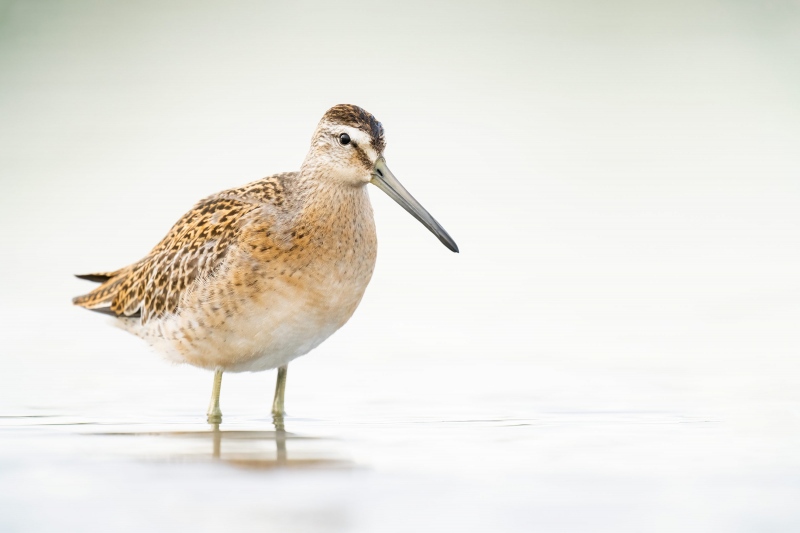
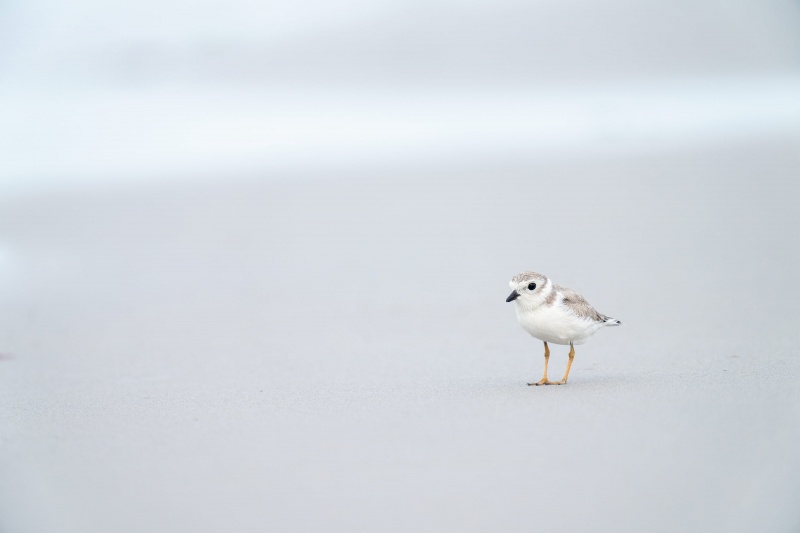
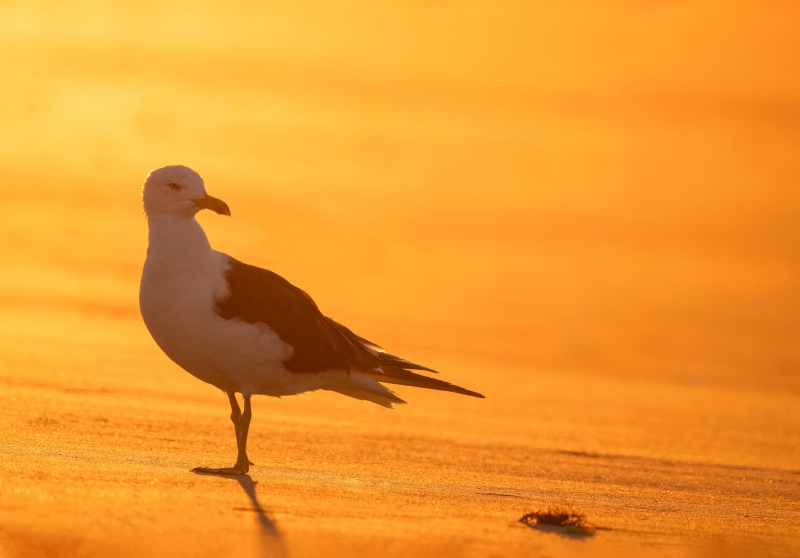
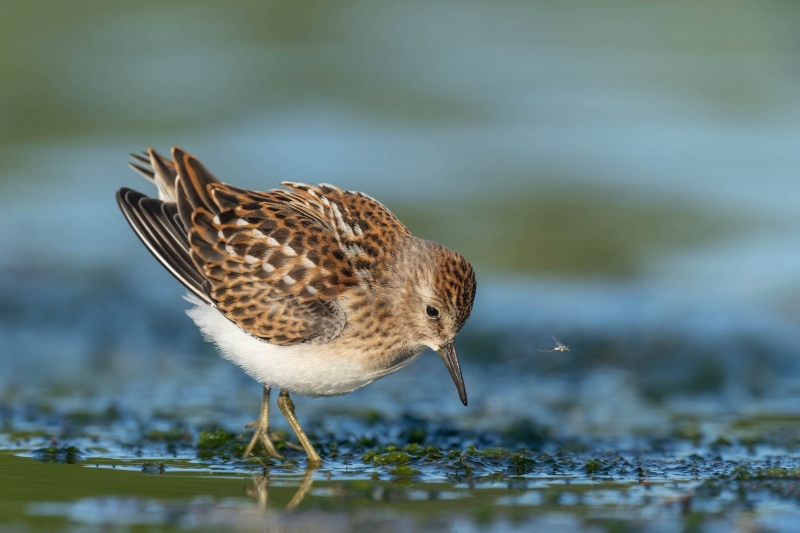
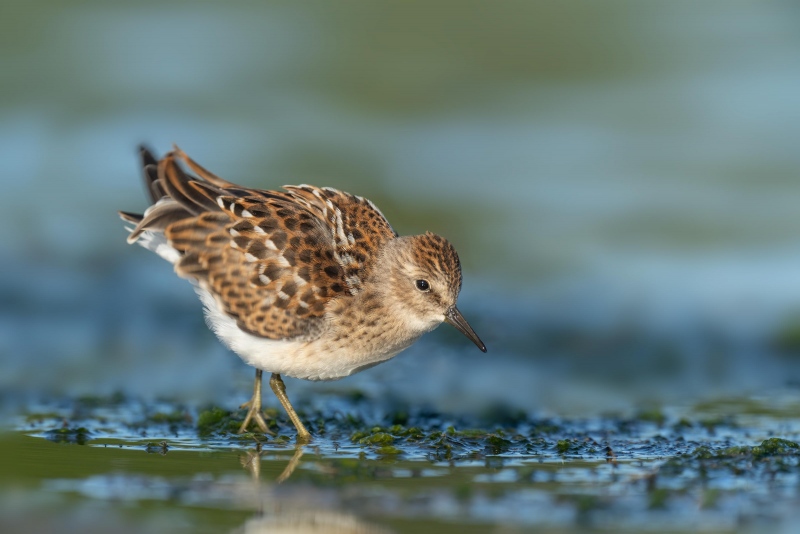
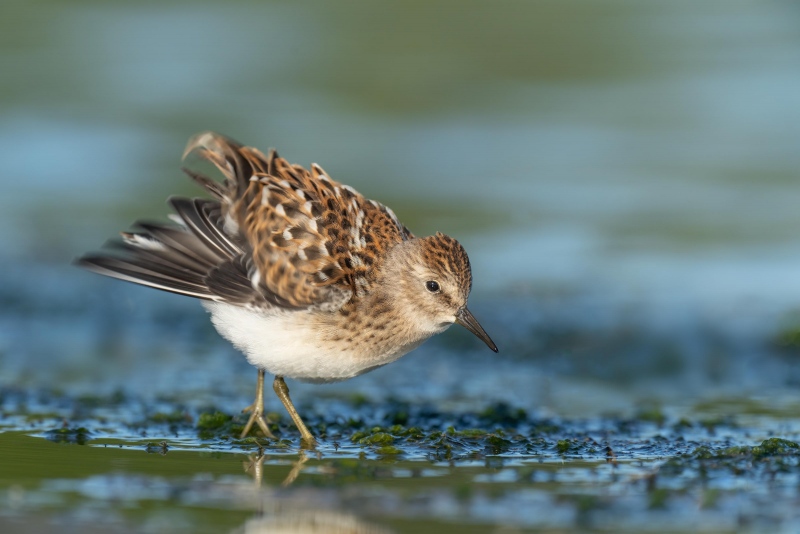













2A as well. It is the most emotive of the series.
2A. The negative or empty space tells a story.
I’m sticking with the birdscape as favorite – #2A it is.
Thanks, dude.
with love, artie